
by DGR News Service | Dec 20, 2019 | Agriculture, Biodiversity & Habitat Destruction, Human Supremacy, Toxification
by Sean Butler and Will Falk / Featured image: an aerial photograph showing harmful algae blooms in Lake Erie in August of 2017. These are believed to be caused by the effluent runoff from factory farms in the watershed. Public domain photo by NOAA.
Rights of nature advocates often repeat the words, “The structure of the legal system makes meaningful environmental protection illegal.” It’s a bold claim, but for most people it’s too vague to mean anything. Most folks (understandably) don’t know the difference between a federal district court and a circuit court of appeals, let alone what we mean by the “structure” of the legal system.
But it’s actually quite simple. We’re referring to two aspects of the American legal system: (1) laws and regulations at the federal, state, and local (city and county) levels and the relative hierarchy among them; and (2) the holdings of various state and federal courts throughout the history of our country, which establish “precedent” for what those laws and regulations actually mean.
Perhaps nowhere in recent memory has the “structure of the legal system” been laid bare more clearly than in the aftermath of the passage of the Lake Erie Bill of Rights by the citizens of Toledo, OH in February 2019. The Lake Erie Bill of Rights (LEBOR) grants Lake Erie the rights to exist, flourish, and naturally evolve; grants the residents of Toledo a right to a healthy environment; and “elevates the rights of the community and its natural environment over powers claimed by certain corporations.”
Although remarkable on its face, LEBOR is only one of dozens of similar local laws that have been passed in recent years in cities and counties across the United States. What is truly remarkable is the response LEBOR has received from existing institutions.
Mere hours after the City of Toledo certified LEBOR’s election results, entrenched interests opposed to environmental protection leveraged the existing structure of American law to mount an urgent opposition to LEBOR. Drewes Farms Partnership (“Drewes Farms”), represented by a corporate law firm, sued the City seeking an injunction against enforcing the law on the basis that LEBOR violates Drewes Farms’ “civil rights.” The State of Ohio was allowed to intervene in the case to argue for LEBOR’s invalidation while the grassroots community group, Toledoans for Safe Water – who drafted LEBOR and ushered it through Ohio’s citizen initiative process — was barred from the case by the federal judge. Then, the Ohio State legislature (at the request of the Ohio Chamber of Commerce) included in its 2019 budget a provision explicitly making it illegal for local governments to make or enforce laws ascribing legal rights to nature.
In short, the existing legal system and those who profit from it brought the full weight of the legal system against LEBOR. To really understand what is meant when we say that the structure of the legal system makes meaningful environmental protection illegal we need to dig into the specifics of this onslaught.
LEBOR’s opponents make primarily two legal arguments against it. First, they claim that LEBOR should be invalidated because it infringes on corporate constitutional rights. Second, they argue that LEBOR is preempted by state and federal law that reserves the right of the state of Ohio and the federal government to legislate on environmental matters.
Drewes Farms makes the corporate constitutional rights argument very clearly in the complaint it filed in federal court, claiming that:
“LEBOR causes real and concrete harms on Drewes Farms by violating the United States Constitution including but not limited to:
- Depriving Drewes Farms of its fundamental right to freedom of speech and to petition the courts under the First Amendment;
- Violating Drewes Farms’ right to equal protection by targeting it for liability based solely on the fact that it operates as a partnership business entity;
- Violating the Fifth Amendment protection against vague laws by exposing Drewes Farms to strict criminal liability and massive damages and fines under a standardless Charter Amendment; and
- Depriving Drewes Farms of its rights without due process.”
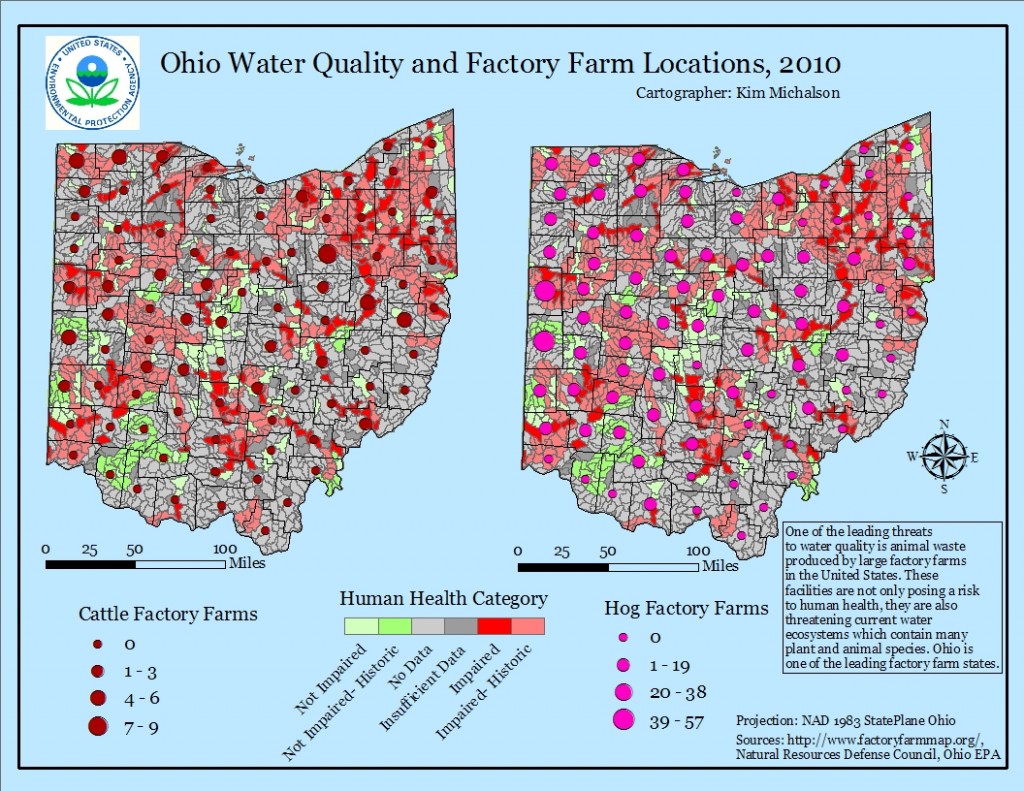
This 2010 map shows the location of major factory farming operations in Ohio and corresponding water quality readings. Ohio has among the highest density of CAFOs (Concentrated Animal Feeding Operations) of any U.S. state. Map by Kim Michalson.
Just so we’re clear, Drewes Farms, a non-human legal entity, lays claim to rights under the First, Fifth, and Fourteenth Amendments to the US Constitution AND claims that those rights are violated by a law that recognizes nature’s right to exist, flourish, and naturally evolve.
Meanwhile, the State of Ohio, in its Complaint for Declaratory Judgment and Injunctive Relief plainly states that “[t]he Ohio Constitution art. XVIII § 3 does not allow a municipality to enact an ordinance that prohibits regulated activity authorized under state permits issued pursuant to state laws of general applicability.” To support its claim, the State cited a recent Ohio case in which the judge ruled “[s]tate laws with state-wide application preempt local ordinances that discriminate, unfairly impede, or obstruct general laws regulating oil and gas activities.” In other words, the Ohio state constitution itself specifically prohibits any local government to enact laws that prohibit activities that are permitted by state laws.
The fundamental issue with both of these arguments is…they are absolutely, totally, and completely right. Under current American jurisprudence, Drewes Farms does have civil rights under the First, Fifth, and Fourteenth Amendments (among others), and LEBOR does violate principles of preemption.
And that is precisely the problem.
Because American law has long recognized corporate civil rights and has long used preemption to invalidate local laws that provide for stricter regulations than federal or state governments, the State of Ohio and Drewes Farms would have us believe that this should be the end of the discussion. But, ending the discussion here leaves several problematic assumptions unchallenged. Arguing that LEBOR should be invalidated because it infringes on corporate rights only makes sense if corporations should enjoy those rights under our system of law. And arguing that LEBOR should never be enforced because it violates established principles of preemption only makes sense if preemption is beneficial to American citizens.
So, we must dig deeper. We must ask: Why do corporations exist? What are corporate rights? Why does the American legal system afford corporations rights in the first place? We must also ask: Why does preemption exist? Why does the American legal system protect the state and federal governments’ power to preempt laws passed by local communities? And, is there a connection between growing corporate power and preemption?
While there is a debate about what corporations should exist to do, the fact remains that corporations exist to amass wealth, or to borrow one of corporate apologists’ favorite phrases, to “maximize shareholder value.” We can see this argument clearly in the hugely influential essay published in 1970 by the Nobel Prize-winning economist Milton Friedman in The New York Times Magazine aptly-titled “The Social Responsibility of Business is to Increase its Profits.” Environmental author and philosopher Derrick Jensen, in The Culture of Make Believe, is more direct:
“To expect corporations to function differently than they do is to engage in magical thinking. We may as well expect a clock to cook, a car to give birth, or a gun to plant flowers. The specific and explicit function of for-profit corporations is to amass wealth. The function is not to guarantee that children are raised in environments free of toxic chemicals, nor to respect the autonomy or existence of indigenous peoples, nor to protect the vocational or personal integrity of workers, nor to design safe modes of transportation, nor to support life on this planet. Nor is the function to serve communities. It never has been and never will be.”
Wealth is power. This is especially true in the legal system. Many people envision law as an all-powerful list of rules that dictates what someone can or cannot do. Similarly, many people think of rights as a list of privileges that specify what a person is entitled to do or entitled to be free from. As such, many people imagine that they can simply invoke these rights to be safe. But, it is a mistake to think that rules written somewhere in a book of statutes or rights listed in the Constitution have the power to jump off the paper where they are written and enforce themselves.
The key to understanding law and rights lies in understanding how they are enforced. Judges enforce law and rights by making decisions in court. And those decisions in court, in turn, are enforced by the police who are entitled to use physical force to ensure a judge’s decision is adhered to. When most people think about how this works, they envision examples such as President Eisenhower’s use of the National Guard to desegregate schools to uphold African Americans’ Fourteenth Amendment rights. But, a more apt and contemporary example is reflected in how the police were used at Standing Rock. Dogs, water cannons, and military-style weapons were turned against nonviolent protesters once the owner of the pipeline project, a corporation, won a favorable court ruling. These corporate rights-holders harnessed the state’s police power through the courts.
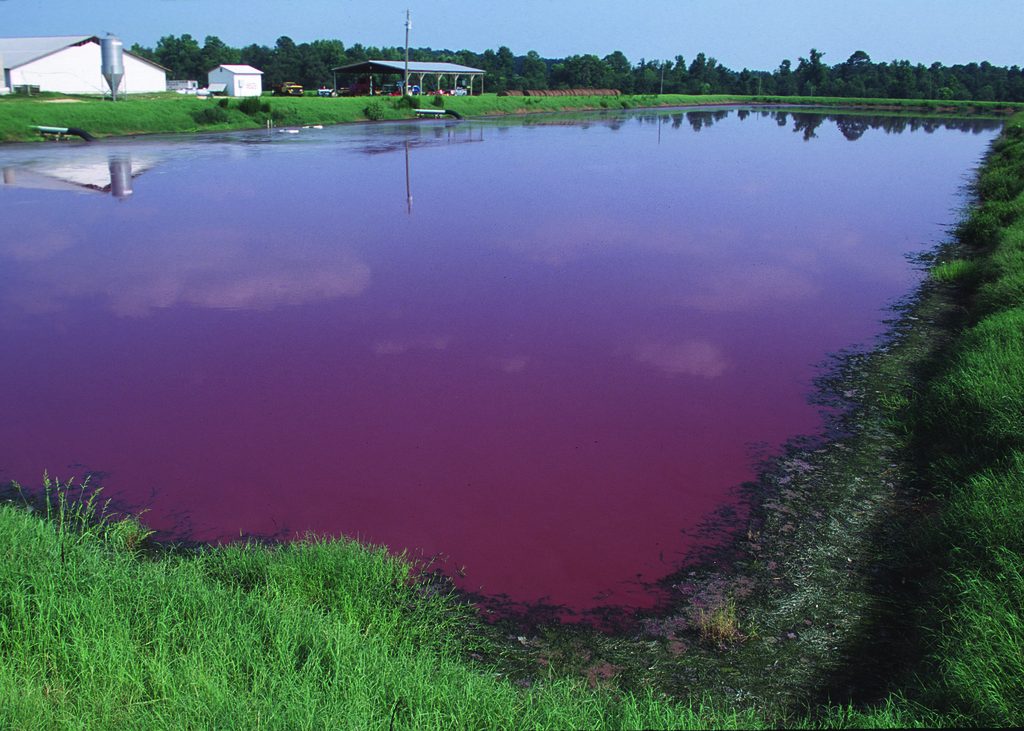
A typical “animal waste lagoon.” These containment ponds continuously leach into groundwater, and often overflow. Public domain photo by NRCS.
Rights, then, are power, too. When shareholders form a corporation, the corporation gains the privilege of “corporate personhood.” Because American courts treat corporations as “persons,” corporations have long exercised rights, including those afforded the highest level of protection under the Bill of Rights’ Contracts Clause, Due Process Clause, Fourteenth Amendment Equal Protection Clause, First Amendment, Fourth Amendment, Fifth Amendment Takings and Double Jeopardy Clauses, Sixth Amendment, and Seventh Amendment.
These rights have, for the most part, been judicially created and have consistently expanded throughout American history. The word “corporation” is found nowhere in the Constitution. Despite this, in 1819, in Dartmouth College v. Woodward, the U.S. Supreme Court ruled that the Contract Clause of the Constitution granted private business corporations protection from governmental interference in internal governance. In 1886, in Santa Clara County v. Southern Pacific Railroad Company, the Supreme Court ruled that a corporation is a person under the law and is therefore entitled to equal protection under the Fourteenth Amendment. In 1922, the Supreme Court ruled in Pennsylvania Coal Company v. Mahon, that coal corporations were entitled to protection under the Fifth Amendment “Takings Clause” and that the government must compensate corporations for property value lost due to mining regulations. In 2010, the Supreme Court ruled that federal laws which limited corporate spending in elections violated corporate First Amendment “free speech” rights in Citizens United v. Federal Elections Committee. Then, in 2014, the Supreme Court, in Burwell v. Hobby Lobby Stores, allowed corporations to deny its employees health coverage of contraception to which the employees would otherwise be entitled because corporations are entitled to First Amendment freedom of religion protection.
This might not seem problematic on its face, but recall that rights only have practical effect to the extent that rights holders can access the courts in order to ask a judge to enforce those rights. Corporations, that exist to, and have grown quite adept at, amassing wealth, have greater means to put behind the legal enforcement of rights. This naturally means more cases won by corporate plaintiffs, more caselaw upholding corporate rights, and therefore, by extension, more caselaw expanding the sphere of corporate civil rights. And the sheer number of cases bear out this reality. As an example, consider this: between 1868, when the Fourteenth Amendment was ratified, and 1912, the Supreme Court ruled on only 28 cases involving the rights of African Americans and an astonishing 312 cases on the rights of corporations, it is easy to conclude that the Fourteenth Amendment has done a better job protecting the rights of corporations than that of African Americans.
At the same time, the expansion of rights in one sphere necessarily produces the curtailing of rights in another. Deep ecologist John Livingston describes the problem:
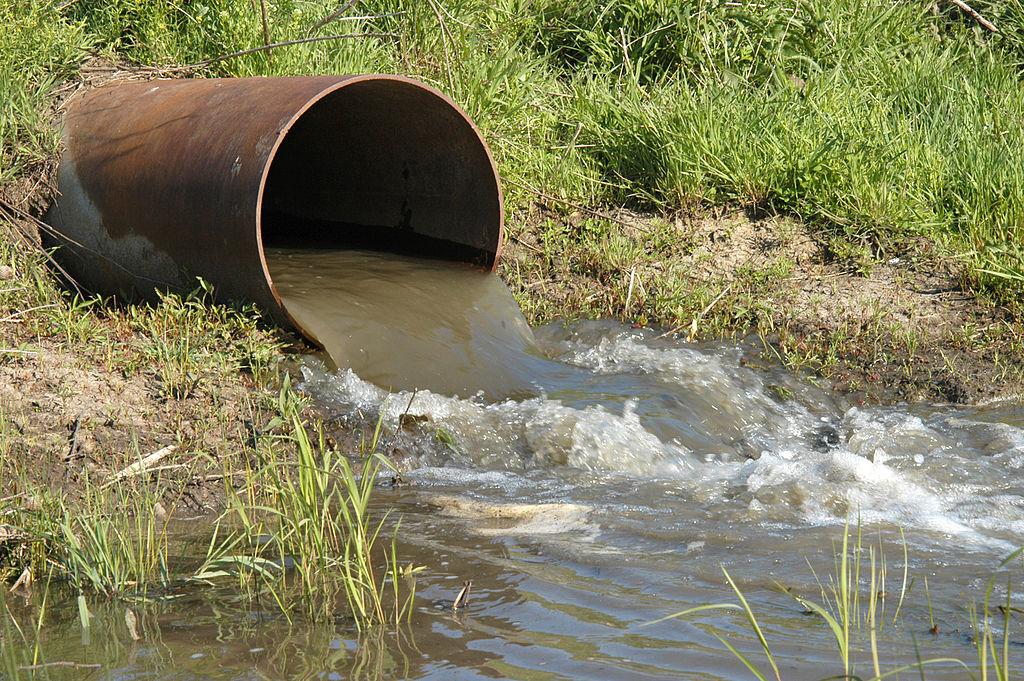
Effluent discharge pipe. Public domain image from USDA.
“We sometimes forget that every time a court or legislature – or even custom – confers or confirms a right in someone, someone else’s right is nibbled at: the right of women to equal employment opportunity is an infringement of the freedom of the misogynist employer; the right to make a profit is at someone else’s cost; the right to run a motorcycle or a snowmobile reduces someone else’s right to peace and quiet in his own backyard; the rights of embryos impinge upon the rights of the women who carry them. And so on.”
In other words, the expansion of corporate rights shrinks the rights enjoyed by citizens and communities. Because American law extends to corporations many of the same constitutional rights humans enjoy and because corporations exist to accumulate wealth, we should not be surprised when corporations use their power to do exactly that at the expense of the rights of human beings and nature.
The other major legal argument made against LEBOR is that it is preempted by state and federal law. Preemption is a doctrine that says the law of a higher jurisdiction should displace the law of a lower jurisdiction when the two jurisdictions conflict. The American legal system is divided basically into three jurisdictions: federal, state, and local law (local law is a general term for the law of the smallest legislating entities American law allows, entities such as municipalities, cities, or villages). When federal and state law conflict, American courts interpret the Supremacy Clause of the United States Constitution (Article VI, Section 2) to mean that federal law should displace state law. Similarly, state law usually trumps local law when the two conflict.
Corporations, using their superior wealth and their constitutional rights, have found tremendous success in influencing federal and state legislatures, especially pro-business, conservative legislatures and persuading them to enact aggressive new preemption laws. When local governments pass laws with stricter restrictions than the federal or state legislatures, corporations lobby legislatures to employ preemption to attack these local laws. This typically happens in one of two ways. First, government lawyers, primarily attorneys general, assert the doctrine of preemption in court. The State of Ohio’s arguments against LEBOR are a perfect example. Second, legislatures pass legislation known as “blanket” preemption to expressly forbid local ordinances that contradict state law. And, in fact, the Ohio House of Representatives recently employed blanket preemption when it adopted its 2020-2021 budget with provisions that prohibit anyone, including local governments, from enforcing rights of nature laws.
That’s what preemption is. The more important question is: Why does American law protect the federal and state governments’ power to preempt laws passed by local communities? The answer, quite simply, is corporate power.
The modern preemption doctrine was born from an 1868 decision written by Iowa Supreme Court Chief Justice John Dillon in The City of Clinton v. The Cedar Rapids and Missouri River Railroad Company. The case involved an attempt by the people of Clinton, Iowa to prevent railroad corporations from building railroads through their town. An ordinance was passed by the Clinton city council which prohibited any “railroad company from constructing its track through or upon any street within the limits of the city, and from occupying the same for right of way or other railroad purposes.”
In the decision, Dillon struck down Clinton’s ordinance and described his philosophy of the limited powers of municipal corporations and other local governing entities. This philosophy is now known as “Dillon’s Rule.” He wrote:
Municipal corporations owe their origin to, and derive their powers and rights wholly from, the legislature. It breathes into them the breath of life, without which they cannot exist. As it creates, so it may destroy. If it may destroy, it may abridge and control. Unless there is some constitutional limitation on the right, the legislature might, by a single act, if we can suppose it capable of so great a folly and so great a wrong, sweep from existence all of the municipal corporations in the State, and the corporation could not prevent it. We know of no limitation on this right so far as the corporations themselves are concerned. They are, so to phrase it, the mere tenants at will of the legislature. 24 Iowa 455, 475.
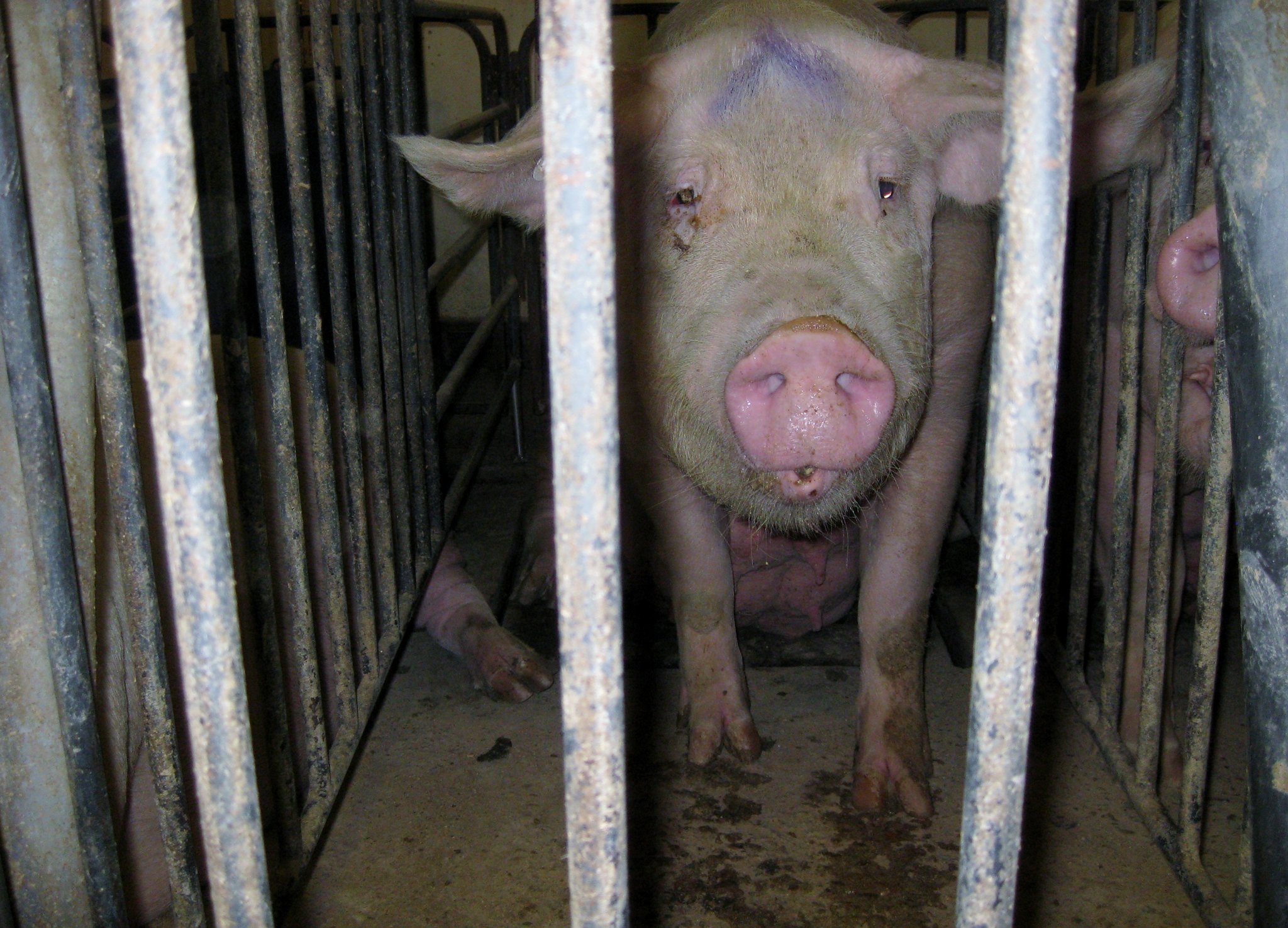
A pig at a factory farming operation. These industrial farms are the largest source of nutrient pollution in Lake Erie. https://creativecommons.org/licenses/by/2.0/ Via Mercy for Animals.
And, Dillon’s Rule was later adopted by the United States Supreme Court in 1907 in Hunter v. Pittsburgh.
As you can see, from the outset, preemption has been, quite literally, about corporations “railroading” local communities who do oppose destructive corporate projects. Today, preemption has grown into a powerful tool wielded by, especially, conservative, pro-business state legislatures. Judge Jon D. Russell and Aaron Bostrom, in a white paper titled “Federalism, Dillon Rule and Home Rule” recently written for the American City County Exchange (an organization that “helps to advance limited government and free market principles in local government through model policies, conferences, and online collaboration”), provide a solid example of the rationale employed by state legislators to defend preempting local laws.
Russell and Bostrom write:
The Dillon Rule guarantees a certain level of uniformity throughout the state…Rather than having vastly different policies and codes in each local jurisdiction, the state can create uniform tax codes and licensing policies, making it a business-friendly environment. Without commonality between local governments on these issues, businesses find more red tape than opportunity, making it difficult for the state and businesses to prosper.
Dr. Lori Riverstone-Newell, an expert in the interaction of governments in the American system, describes how in the past few years, “a growing number of state officials have sponsored and supported preemption legislation with the intent to weaken local authority and to thwart local progressive policies.” In simpler terms, conservative state legislators are learning how to use preemption to prevent progressive communities from enacting progressive laws.
We can see why some commentators argue we live in a corporate state. If the fundamental element of a democracy is the right of the people to enact and enforce the laws to which they are subject, then preemption is fundamentally an anti-democratic concept, especially as the doctrine has been influenced and wielded by entrenched economic interests and the state and federal legislators who support (and who are, of course, supported by) those interests.
Indeed legislators are not working alone; they are implementing policies pushed by corporate lobbyists. Dr. Riverstone-Newell explains, “Recent preemption efforts can be understood, at one level, as part of longstanding campaigns waged by industry groups hoping to stop or limit progressive local policies in order to create a friendlier business environment for themselves.” She describes how industry groups and trade associations first began pressuring state legislatures to rein in their cities in the late 1980s. R.J. Reynolds, the tobacco corporation, “pressed states to enact preemption laws in the 1980s as a central strategy to overcome local smoking restrictions and bans.” Abby Rapoport, a journalist writing for The American Prospect, reports how the National Rifle Association launched a campaign in the 1990s for state preemption of local gun regulations. This campaign was so successful “43 states now have some form of maximum preemption preventing localities from passing additional gun regulations on top of state law.”
It may very well be that “a certain level of uniformity” of laws in different jurisdictions enables business to “prosper,” but having reached the point in our nation’s history where we are confronting ecological collapse, we have to ask ourselves, whether blanket uniformity and unchecked economic growth and prosperity are the only values that matter to us. Or, instead, might it be that local environmental protection laws are key to protecting local ecology? Might it be that the unique ecosystems in one ‘jurisdiction’ require unique laws and regulations in order for them to thrive? Why should we expect that laws protecting swamplands in Florida be the same as those protecting the Nevada desert? If we are to see our way through the current environmental crisis, we can’t simply accept the doctrine of preemption on its face; we must consider the value of it, and its history and development, in order to determine whether or not it is compatible with the future we want for our grandchildren and the planet.
The failure to recognize how American law makes sustainability illegal is a primary reason environmentalists have failed to keep the health of the North American continent from deteriorating over the last century. Because we fail to recognize this, we keep seeking to protect the natural world through legal and political processes that do not – cannot – work. The late corporate anthropologist Jane Anne Morris described our predicament clairvoyantly:
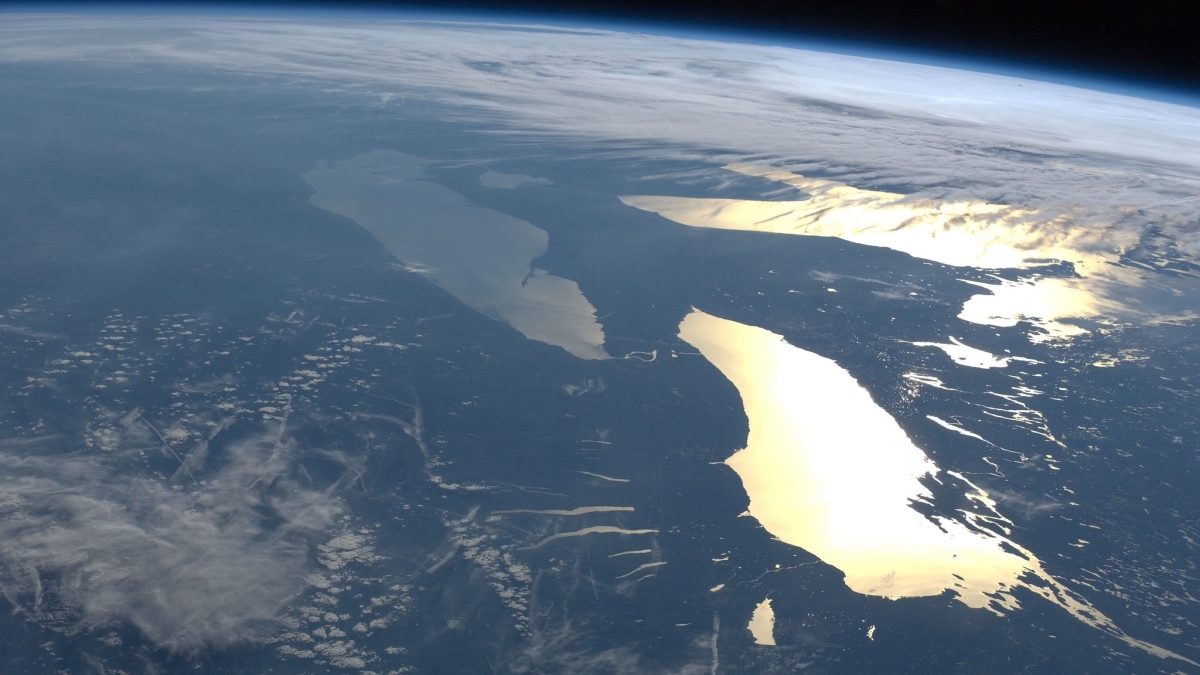
Lake Erie (left) is the 11th largest lake in the world. Public domain NASA photo.
“Our campaigns follow the gambling addiction model. The last bet didn’t pay off but the next one might if…if…if we just had a new, improved tripod, three more experts, more labor or church support, ten more elected officials on our side, a hundred more people at the demo, or a thousand more letters in the mail…Who are we kidding? We are just doing the ‘same old thing’ over and over again and fooling ourselves that it might work next time. We are stuck in a feedback loop where our failures are interpreted as signs that we should repeat our failed tactics, but try harder. This is what it is to be colonized.”
Lawyers, and their clients, are especially vulnerable to falling victim to Morris’ gambling addiction model. The adversarial, competitive nature of law where two or more sides jockey for the approval of a judge makes it easy for losing parties to conclude that if they just hired a more expensive law firm, or if they just argued an issue differently, or if they just cited this case instead of that case then they would have won. The problem, however, is not that we need to try harder; the problem is that the structure of American law prevents our ability to implement strong enough measures to truly protect the natural world.
The people of the City of Toledo, recognizing that corporate rights and preemption must be confronted and overturned to protect Lake Erie and all those who depend on her, voted to enact the Lake Erie Bill of Rights. The arguments made by the State of Ohio and Drewes Farms Partnership are currently the law en vogue. This is one of the major reasons American law makes sustainability illegal. This must change if the natural world, and all of us who depend on her, are going to survive the current ecological predicament. To achieve a sane, sustainable culture, corporate rights and preemption must go.
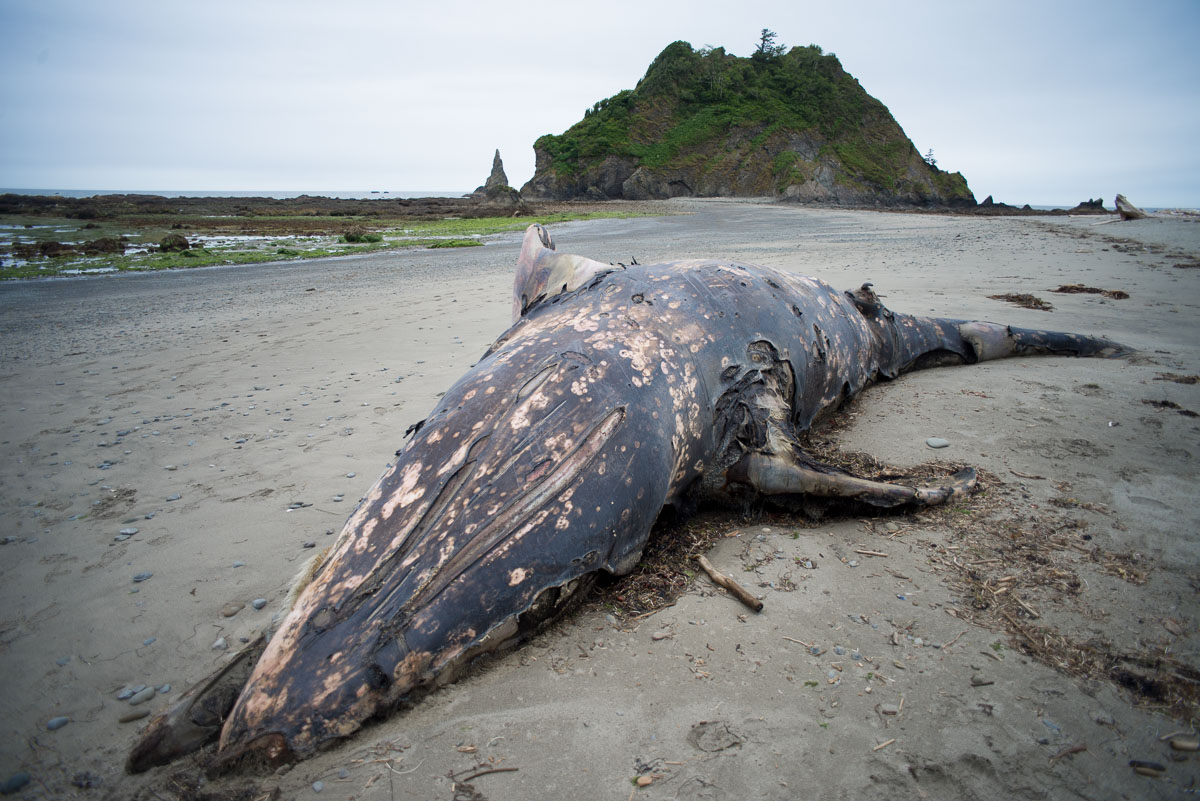
by DGR News Service | Dec 18, 2019 | Agriculture, Biodiversity & Habitat Destruction, Climate Change, Mining & Drilling, The Problem: Civilization, Toxification
A series of headlines from around the world, compiled by Max Wilbert and Mark Behrend. Featured image by Max Wilbert.
2019 Was the 2nd Hottest Year on Record
Global average temperature reached the 2nd highest annual level ever recorded, according to preliminary data for 2019. While the data is not yet finalized, it’s almost certain 2019 will go down as the 2nd hottest ever. The hottest five years on record have been the last five years, and we are in the final days of the hottest decade in the record.
https://twitter.com/ClimateOfGavin/status/1206608106819661826
70,000 Children Have Been Detained at the U.S. Border in 2019
As climate crisis and ecological collapse drives ever more migration, abuse at the southern border of the U.S. is escalating. One recent report finds that nearly 70,000 children have been detained in 2019:
The story lays out in excrutiating detail the emotional pain of victims of President Donald Trump’s child separation policy, focusing on, among others, a Honduran father whose three-year-old daughter can no longer look at him or connect with him after being separated at the U.S. border and abused in foster care.
“I think about this trauma staying with her too, because the trauma has remained with me and still hasn’t faded,” the father told AP.
The 3-year-old Honduran girl was taken from her father when immigration officials caught them near the border in Texas in March 2019 and sent her to government-funded foster care. The father had no idea where his daughter was for three panicked weeks. It was another month before a caregiver put her on the phone but the girl, who turned four in government custody, refused to speak, screaming in anger.
“She said that I had left her alone and she was crying,” said her father during an interview with the AP and Frontline at their home in Honduras. “‘I don’t love you Daddy, you left me alone,'” she told him.
https://www.commondreams.org/news/2019/11/12/causing-profound-trauma-trump-administration-detained-record-breaking-70000-children
Koalas Declared “Functionally Extinct” After Fires Destroy 80% of Remaining Habitat
Experts believe the long-term outlook for the species is bleak, after centuries of habitat destruction, overhunting, and culling.
https://www.forbes.com/sites/trevornace/2019/11/23/koalas-functionally-extinct-after-australia-bushfires-destroy-80-of-their-habitat/#4dfb62fc7bad
Light Pollution is Key ‘Bringer of Insect Apocalypse’
Light pollution is a significant but overlooked driver of the rapid decline of insect populations, according to the most comprehensive review of the scientific evidence to date.
Artificial light at night can affect every aspect of insects’ lives, the researchers said, from luring moths to their deaths around bulbs, to spotlighting insect prey for rats and toads, to obscuring the mating signals of fireflies.
“We strongly believe artificial light at night – in combination with habitat loss, chemical pollution, invasive species, and climate change – is driving insect declines,” the scientists concluded after assessing more than 150 studies. “We posit here that artificial light at night is another important – but often overlooked – bringer of the insect apocalypse.”
https://www.theguardian.com/environment/2019/nov/22/light-pollution-insect-apocalypse
Sea Ice Update:
Arctic sea ice extent for November 2019 ended up at second lowest in the 41-year satellite record. Regionally, extent remains well below average in the Chukchi Sea, Hudson Bay, and Davis Strait.
October daily sea ice extent went from third lowest in the satellite record at the beginning of the month to lowest on record starting on October 13 through October 30. Daily extent finished second lowest, just above 2016, at month’s end. Average sea ice extent for the month was the lowest on record. While freeze-up has been rapid along the coastal seas of Siberia, extensive open water remains in the Chukchi and Beaufort Seas, resulting in unusually high air temperatures in the region. Extent also remains low in Baffin Bay.
https://nsidc.org/arcticseaicenews/
Gemeni Solar Project Threatens Important Habitat in Nevada
The US Fish and Wildlife Service (FWS) recently released a document identifying the severe impacts that would be inflicted on the Mojave desert tortoise (Gopherus agassizii) from the Gemini Solar Project, located in southern Nevada. The agency, tasked with recovering rare species headed for extinction, wrote a Biological Opinion for the Bureau of Land Management (BLM), the agency in charge of permitting the 7,100 acre Gemini Solar Project which will be located on public lands near Valley of Fire State Park, as part of its consultation process. BLM is reviewing an Environmental Impact Statement for the project.
Although the document claims that mitigation measures will make up for the impacts, the FWS claims that the Gemini Solar Project could kill or injure as many as 1,825 federally threatened desert tortoises in its 30-year operational lifespan. While the Biological Opinion assures us that the project would be heavily mitigated, it still raises dire concerns about these impacts.
The Mojave desert tortoise had declined so drastically decades ago that in 1990 the U.S. Fish and Wildlife Service listed the species as federally threatened. In the year 2000 the FWS began systematically surveying desert tortoise population numbers across its range using the latest scientific methods. What they saw was continuing declines of tortoise numbers, and even population crashes. Based on these surveys the Desert Tortoise Council has recently recommended up-listing the status of the Mojave desert tortoise from a threatened status to a higher endangered status–which means an emergency to stave off extinction.
The vegetation would be mowed using 23,000 pound Heavy Duty mulchers. Because not all individual tortoises will be detected by biologists or project staff, the agency is concerned that death and injury of desert tortoises could result from excavation activities such as clearing of vegetation, and entrapment in trenches and pipes during construction. Tortoises could be crushed by heavy vehicles. The FWS claims tortoise burrows would be avoided during all this constriction and maintenance activity with equipment and vehicles over years, but we have seen tortoise home burrows crushed and caved in by such activities on other development projects.
After solar project construction is complete and hundreds of tortoises are dug up and raided out of their burrows, the agencies are proposing to then release them back on to this disturbed habitat. The presence of re-occupied desert tortoises on the solar site, with vehicle traffic, may result in injuries or death during routine maintenance of facilities such as vegetation trimming. Tortoises outside of the fenced solar site may also be injured or killed due to truck traffic along the transmission lines and associated access roads.
Capture and translocation (moving) of desert tortoises may result in death and injury from stress or disease transmission associated with handling tortoises, stress associated with moving individuals outside of their established home range, stress associated with artificially increasing the density of tortoises in an area and thereby increasing competition for resources, and disease transmission between and among translocated and resident desert tortoises.
Translocation has the potential to increase the prevalence of diseases, such as Upper Respiratory Tract Disease (URTD), a major mortality factor for desert tortoises. Stresses associated with handling and movement could exacerbate this risk in translocated individuals that carry diseases. Equally, desert tortoises in quarantine pens could increase their exposure and vulnerability to stress, dehydration, and inadequate food resources.
The Gemini Solar Project represents an unacceptably large threat to tortoise populations, connectivity, and high-quality habitat in the northeastern Mojave Desert. FWS appears to us to be minimizing the threat of this project and recommending mitigation measures that will fail to halt tortoise mortality and further cumulative habitat degradation.
http://www.basinandrangewatch.org/
Australia Bushfires Rage
3900 square miles of Australia (an area more than 3 times the size of Yosemite National Park) were burned during a single week of November. – New York Post, 11/26/2019
Rice Farming is Major Source of Methane Emissions
Rice farming, long believed responsible for 2.5% of carbon emissions, is now believed to emit up to twice as much — due to new farming methods that only burn the fields intermittently, rather than annually. Leaving the fields in standing water has been found to stimulate bacterial growth that adds the equivalent of 1200 coal-fired power plants in carbon emissions. – Independent (online news magazine), 09/10/2018
The Plastic Pollution Explosion
A deer found dead in rural Thailand recently had 18 pounds of plastic in its stomach. – CNN, 11/26/2019
Consumer Culture Metastasizing Across the Globe
France says that Black Friday is the worst ever American import, topping Halloween and McDonald’s. The one-day shopping frenzy is said to produce the equivalent of a truckload of textiles being dumped every second, across France. – France 24, 11/30/2019
E-Waste is Growing Fast
Electronic waste worldwide is expected to exceed 50 million tons annually by 2020. Before it becomes e-waste, producing a single computer and monitor requires 1.5 tons of water, 48 lbs. of chemicals, and 530 lbs. of fossil fuels. – “The Balance SMB (balancesmb.com), 10/15/2019
Amazon Deforestation Accelerating Under Bolsonaro
Amazon deforestation in 2019 (so far) is estimated at more than 1130 square miles, an area equal to 97% of Yosemite. – CNN, 11/14/2019
Another estimate puts Amazon deforestation at 3700 square miles thus far this year.
Sea of Okhotsk Warming Rapidly
Parts of the Sea of Okhotsk, between Siberia and Japan, are now 3° C. warmer than in pre-industrial times. Oxygen levels in the sea are down, and the Okhotsk salmon population has declined 70%, just since 2004. With colder areas of the planet reacting fastest to climate change, scientists fear that what is happening around Okhotsk is a warning for seas and sea life globally. – Washington Post, 11/12/2019
Air Pollution in India
Forty percent of school children in four of India’s largest cities have lung capacity described as “poor” or “bad,” following breathing tests. Air quality in Indian cities is consistently rated among the worst in the world. – India Times.com, 05/05/2015
Niger is Desertifying Rapidly
In Niger, an area of grasslands equal to 110,000 football fields is lost every year to desertification and erosion. Nomadic herdsmen, who have followed this lifestyle for centuries, blame climate change. Some report losing half of their herds in recent years, and say they are now being driven into cities to look for work. – France 24, 12/05/2019
30-40% of Food is Wasted for “Cosmetic Reasons”
Thirty to forty percent of American farm produce never makes it to market, due to inefficient distribution, and to discarding for cosmetic reasons. – France 24, 11/30/2019
Alaska Temperatures Caused Salmon to Have Heart Attacks
Record high temperatures across portions of Alaska caused thousands of salmon to have heart attacks and die last summer.
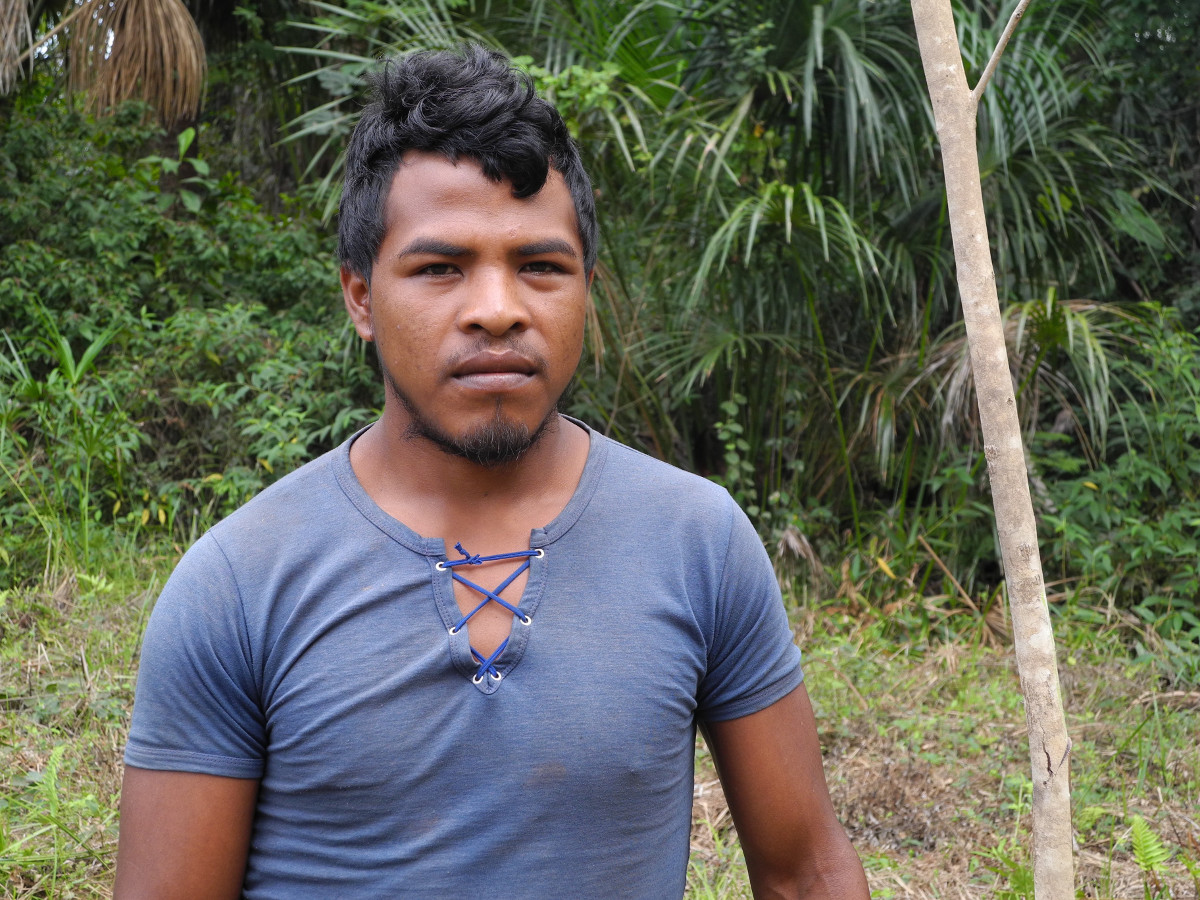
by DGR News Service | Nov 6, 2019 | Biodiversity & Habitat Destruction, Colonialism & Conquest, Defensive Violence, Direct Action, Human Supremacy, Movement Building & Support
Image: Sarah Shenker, Survival International
by Liam Campbell
Paulo Paulino Guajajara, known as Kwahu, has been murdered by loggers in a part of the Amazon currently occupied by the Brazilian government. Equipped with only rudimentary weapons and body armour, and lacking medical assistance, Rainforest Guardians like Guajajara regularly face death at the hands of both government officials and natural resource exploiters. Their only advantages are their intimate knowledge of the rainforest and their deep commitment to protecting those living systems. Guajajara was protecting both his own ancestral land and also the lands of their uncontacted neighbours, the Awá tribe, when he was shot and killed by assassins. Guajajara is not the first ecological activist to be murdered; in April, 3 Rainforest Guardians were similarly slain.
It’s difficult to write this article from the relative luxury and comfort of a Western European country, especially having experienced a small modicum of the difficulties of even living for a few days in jungles like the Amazon — let alone inhabiting those claustrophobic settings with the knowledge that well armed groups of men are hunting for you. I cannot even begin to imagine the courage Guajajara must have embodied in order to take on this critical work; ultimately these words are cheap compared to the very real actions of Rainforest Guardians. We must extend our support beyond words if we’re to meaningfully help them achieve their mission of protecting the world’s dwindling rainforests.
These courageous groups need funding for better defensive weaponry, body armour, combat medicine, training, and basic survival equipment. If we are unable or unwilling to put our own bodies on the front lines to protect nature, then we should share what resources we do have to protect the bodies of people who are willing to put their own lives at risk for the rest of us. Groups like Survival Interntional have a good reputation, or reach out to a Deep Green Resistance representative for additional recommendations.
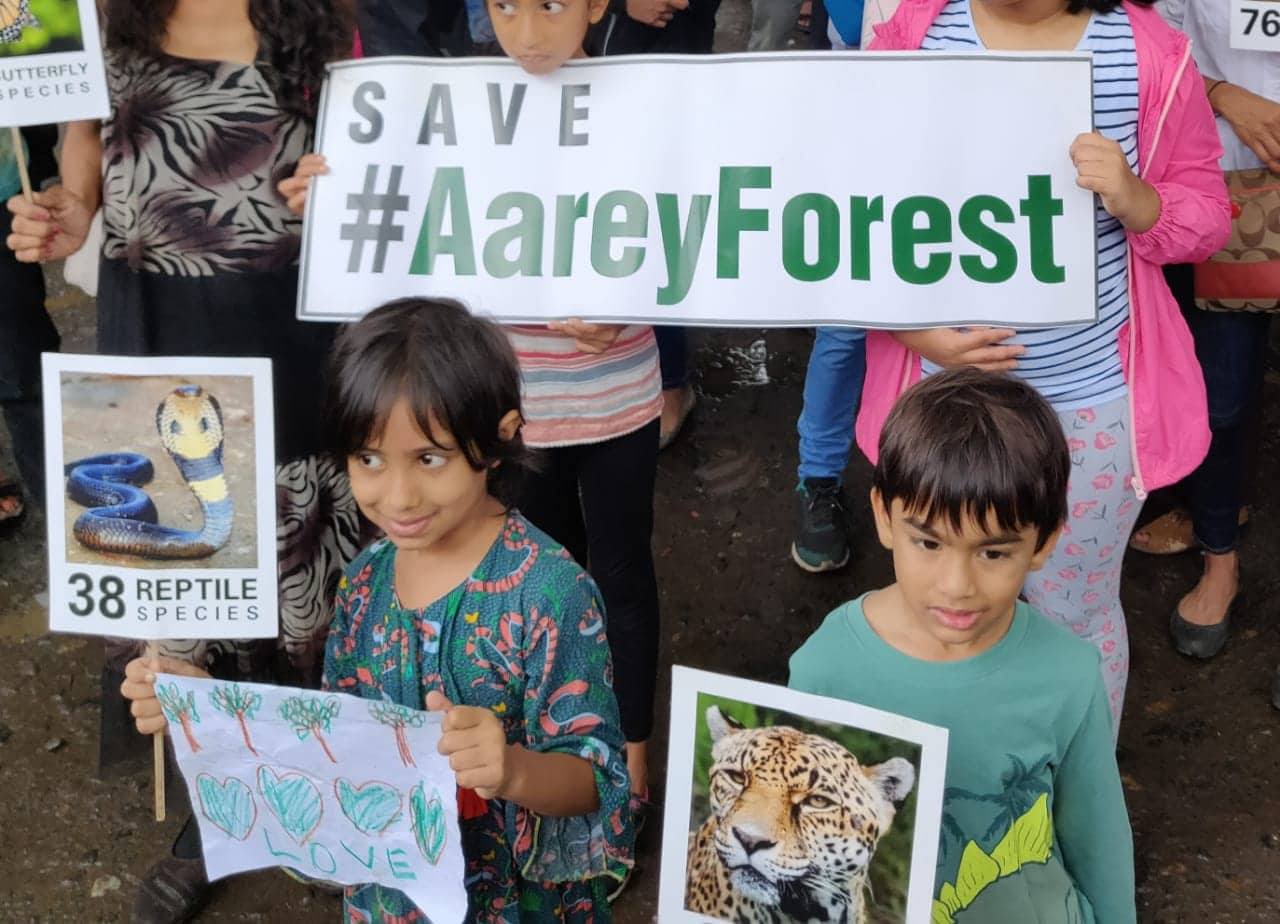
by DGR News Service | Oct 21, 2019 | Biodiversity & Habitat Destruction
By Salonika Neupane / Photos: Jalpesh Mehta (Empower Foundation) via Let India Breathe
Deforestation has been a major contributing factor towards environmental problems. Trees, in addition to providing oxygen, also sequester carbon. By cutting down trees, the amount of carbon dioxide in the atmosphere increases sharply, contributing to the problem of greenhouse effect.
Despite these often irrevocable damages, a 2015 study estimates that a total of 46% of trees have been felled since humans began cutting down trees. Deforestation often occurs due to commercial logging, or to turn the forest land for agricultural purposes (as is the case with the current deforestation in Amazon rainforest). In developing countries, a major cause of deforestation is the supposed development projects. These projects are often masked as an essential part of development, and any group opposing these projects are labeled “anti-development”, which makes it even more difficult for people to begin to question the necessity of the projects. Those who do resist have to spend valuable time and energy fighting off these labels.
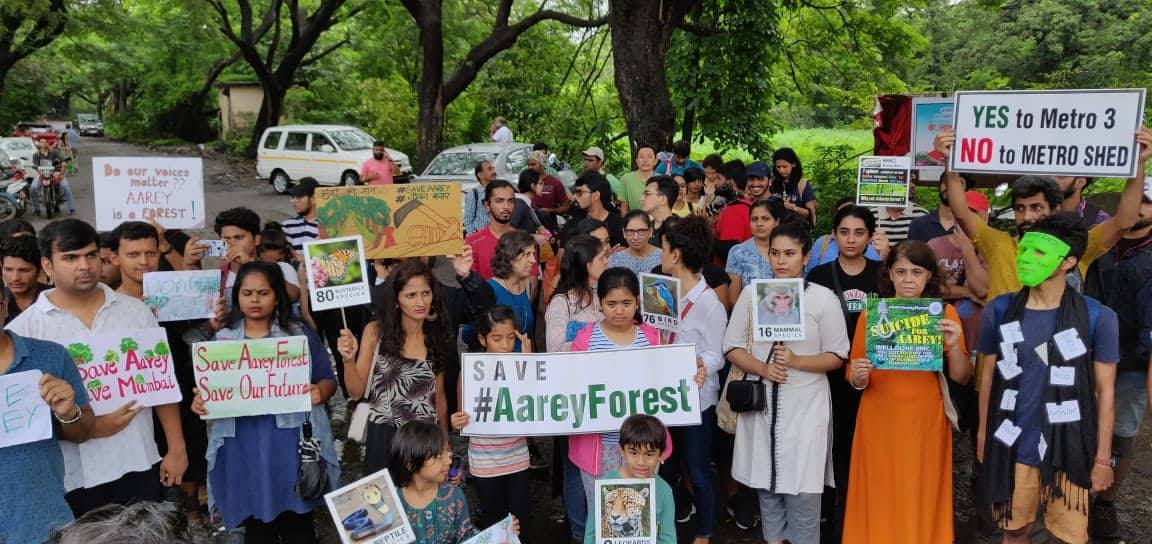 In India and Nepal, two “development” projects have been proposed that require felling of trees. In Mumbai, over 2600 trees in the Aarey area are to be felled to build a car shed (parking garage) for the Mumbai Metro Rail Corporation (MMRC). Aarey is a lively forest with a thriving natural community (aka ecosystem). Yet, Bombay High Court has failed to acknowledge Aarey as a forest. Meanwhile in Nepal, the ring road (encircling the Kathmandu valley) is set for its second phase of road expansion that is going to cut more than 2000 trees.
In India and Nepal, two “development” projects have been proposed that require felling of trees. In Mumbai, over 2600 trees in the Aarey area are to be felled to build a car shed (parking garage) for the Mumbai Metro Rail Corporation (MMRC). Aarey is a lively forest with a thriving natural community (aka ecosystem). Yet, Bombay High Court has failed to acknowledge Aarey as a forest. Meanwhile in Nepal, the ring road (encircling the Kathmandu valley) is set for its second phase of road expansion that is going to cut more than 2000 trees.
Both of the projects have been presented as a necessity for transportation of local people. But the general news fail to address some important facts. For example, in Mumbai, the Aarey forest is being cut down for a car shed of MMRC, not for the railways itself. Railways may play a significant role for the general public of Mumbai, but the car shed does not. On top of that, the MMRC is said to plant 100 times more trees than they cut down. Granting the naiveté of believing in that promise, saplings cannot replace an entire natural community.
Similarly, the road expansion of ring road is sold out as a magical solution to the problem of overcrowded traffic in Kathmandu. None of the residents in Kathmandu would debate that overcrowding of traffic is not a problem in Kathmandu. Yet, time and again it has been demonstrated that road expansions are only a temporary solution to the problem. Within a few years, the number of private vehicles also rise, culminating in the problem of overcrowded traffic of similar, if not worse, intensity. Not to mention, the initial phase of road expansion has caused a sharp increase in the number of road accidents in Kathmandu, causing the recently expanded area to be called the “death trap”.
The deforestation has not gone unnoticed in both of the cities. Environmental groups and local people have both protested against both of these. The intensity of public support for protest is stronger in Mumbai than in Kathmandu, with politicians and celebrities coming up against the proposed deforestation in Mumbai.
Yet, deforestation in both of these areas have begun despite the protests. After the Bombay High Court permitted the project to continue on Friday, MMRC workers began to cut down trees in the middle of the night. The time was chosen so that protesters would not be able to protect the forest. The next day, cutting down trees continued with police protection despite the protests. Many of the activists were arrested. On Monday, the Supreme Court of India issued a stay order in the tree-felling, but over 2100 trees have already been cut.
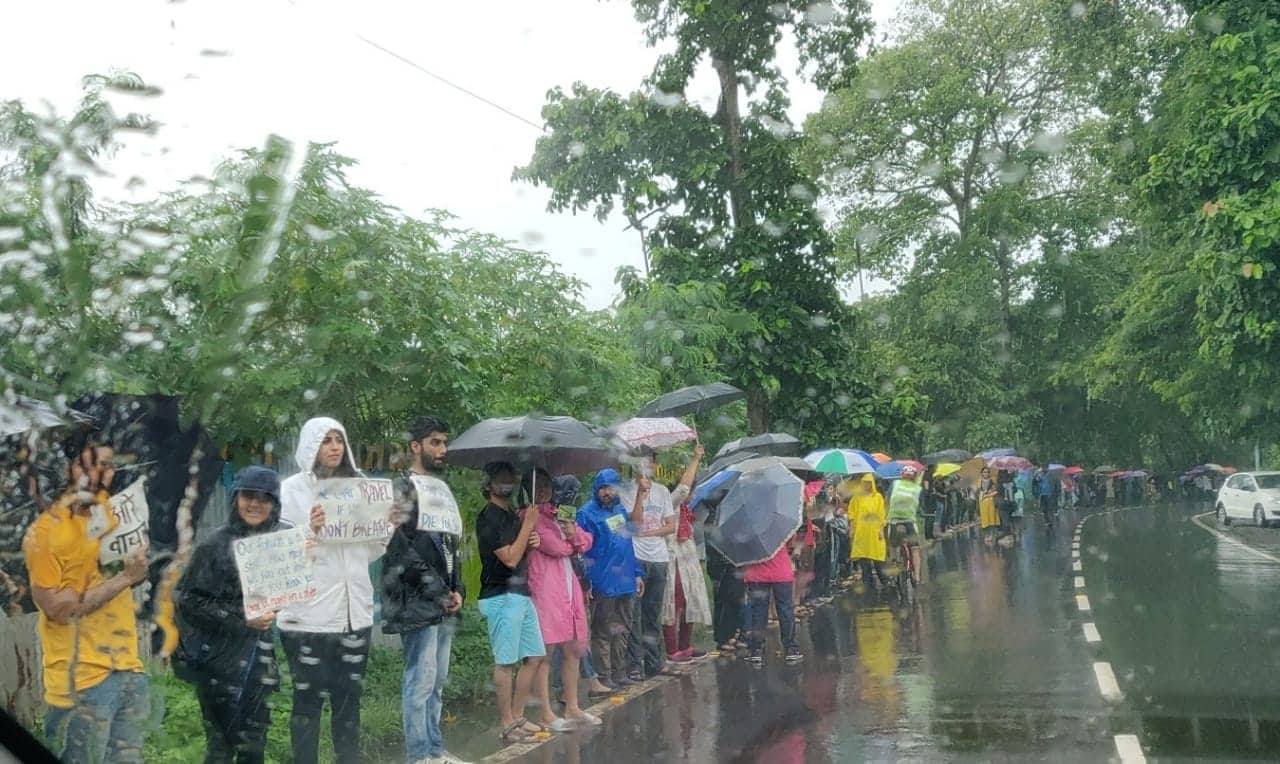 In Kathmandu, cutting down trees began during a major festival of the country. Kathmandu, being the capital, is populated with many immigrants from all over the country. During this time, most return to their natal homes to celebrate the biggest festival of the year with their family and relatives. As a result, the valley is relatively sparsely populated. It was during this opportunistic period that felling of trees began.
In Kathmandu, cutting down trees began during a major festival of the country. Kathmandu, being the capital, is populated with many immigrants from all over the country. During this time, most return to their natal homes to celebrate the biggest festival of the year with their family and relatives. As a result, the valley is relatively sparsely populated. It was during this opportunistic period that felling of trees began.
Protests against deforestation has been rising globally, which may have had an influence in the protests in Mumbai and Kathmandu as well. The Climate Strike movements initiated by Greta Thunberg has helped spark a discussion against climate change in general. Thus, people have become more aware regarding environmental issues. Similarly, people across the world have been opposing the plan for the Brazilian government to allow agricultural industry to clear parts of the rainforest. It has helped bring attention to the significance of forests. Indigenous people have always resisted against the felling of trees. In some cases, indigenous communities have taken matters into their own hands to prevent illegal logging.
Effective strategies often need to address the specific nature of the problems within each context. While the two problems (in Mumbai and Kathmandu) appear similar, there are some major differences. Protests in Mumbai has been able to attract a very high number of supporters, which unfortunately is not the case in Kathmandu. With an exception of environmental groups and a minority of people, it seems the general public have accepted roads expansion as a miraculous cure to the problem of overcrowding of traffic.
As such, the two problems also require different strategies for action. For the Aarey conversation, what is required now is to provide tools to the protesters, like legal support. For the people in Kathmandu, a more basic approach is required: to get the people to question the necessity and fruitfulness of the road expansion in the first place.
References
Choudhary, Amit Anand, & Mehta, Manthan K. (2019, October 8). SC stays tree-felling at Aarey till October 21, but 98% already cut. Published in The Times of India. Accessed from https://timesofindia.indiatimes.com/india/sc-stays-tree-felling-at-aarey-till-october-21-but-98-already-cut/articleshow/71485076.cms
Crowther, T. W. et al. (2015). Mapping tree density at a global scale. Nature, 525, 201-205. Abstract available at https://www.nature.com/articles/nature14967
Ojha, Anup. (2018, May 26) Ring Road part ‘death trap’. Published in The Kathmandu Post. Accessed from https://kathmandupost.com/national/2018/05/26/ring-road-part-death-trap
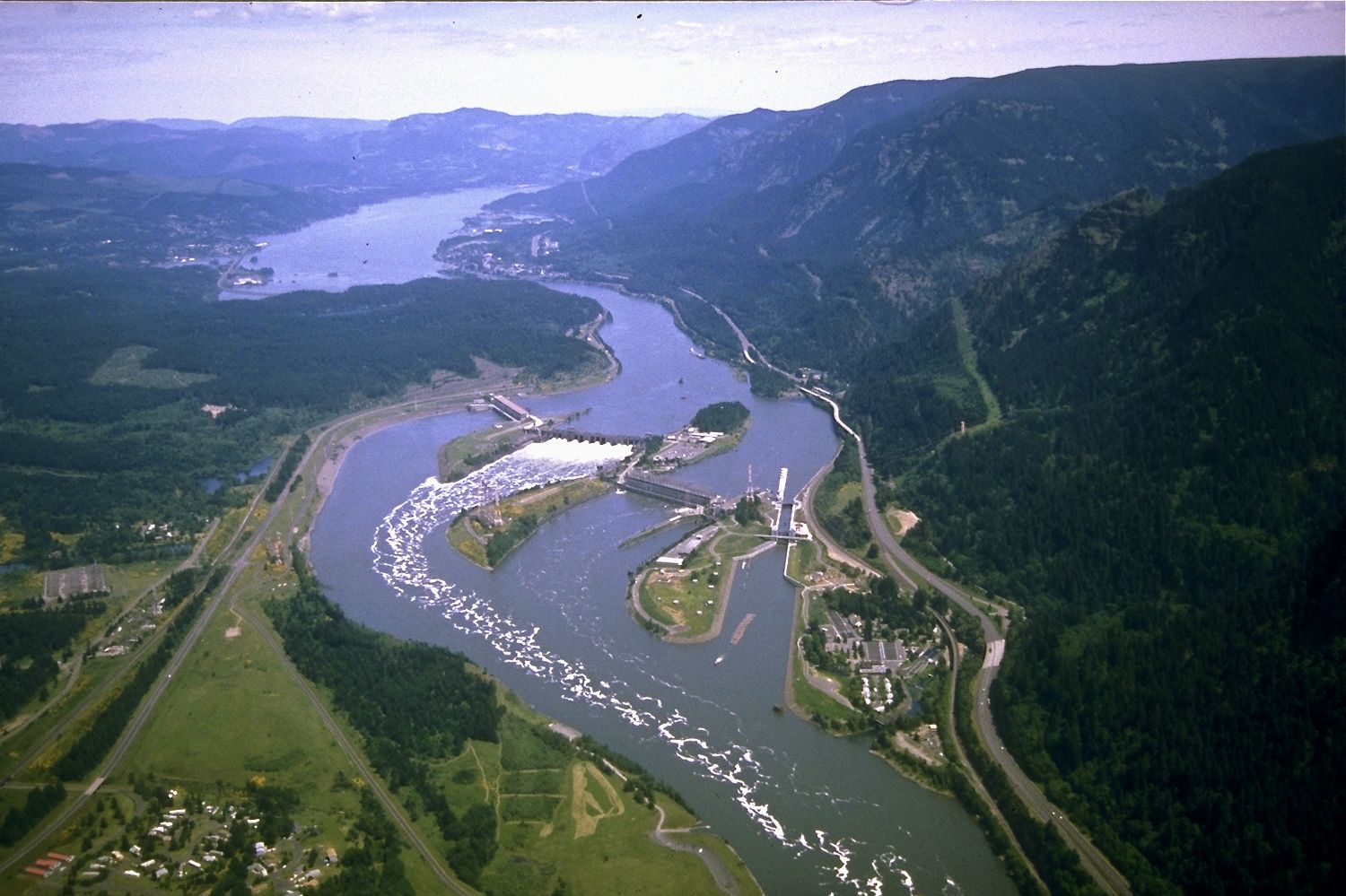
by DGR News Service | Oct 18, 2019 | Biodiversity & Habitat Destruction, Indigenous Autonomy
Editors note: The Columbia River has been turned into a slave of civilization, forced to provide hydroelectricity, barge transport, and irrigation water to cities and big agribusiness. It is shackled in concrete and dying from dams, from overfishing, from toxins, from nuclear waste, from acoustic barrages and armored shorelines and logging and endless atrocities.
We at Deep Green Resistance do not believe that the federal government will accede to demands such as these. Furthermore, there are thousands of dams currently under construction or proposed worldwide. There are millions of dams in the “United States.” The salmon, the Orca whales—they have no time to waste. Everything is heading in the wrong direction. Therefore, we call for a militant resistance movement around the world to complement aboveground resistance movements and to dismantle industrial infrastructure.
Featured image: The Columbia River is constrained by Bonneville Dam, and bracketed by clearcuts, highways, and utility corridors. Public domain.
Confederated Tribes and Bands of the Yakama Nation
On Indigenous Peoples’ Day, October 14, 2019, the Yakama Nation and Lummi Nation hosted a press conference urging the removal of the lower Columbia River dams as part of a broader call for federal repudiation of the offensive doctrine of Christian discovery, which the United States uses to justify federal actions that impair the rights of Native Nations. The press conference took place this morning at Celilo Park near Celilo Village, Oregon.
“The false religious doctrine of Christian discovery was used by the United States to perpetuate crimes of genocide and forced displacement against Native Peoples. The Columbia River dams were built on this false legal foundation, and decimated the Yakama Nation’s fisheries, traditional foods, and cultural sites,” said Yakama Nation Tribal Council Chairman JoDe Goudy. “On behalf of the Yakama Nation and those things that cannot speak for themselves, I call on the United States to reject the doctrine of Christian discovery and immediately remove the Bonneville Dam, Dalles Dam, and John Day Dam.”
The doctrine of Christian discovery is the fiction that when Christian European monarchs obtained what was for them new knowledge of the Western Hemisphere, those monarchs had a religious right of domination over all non-Christian lands. This doctrine was propagated by the Roman Catholic Church through a series of papal bulls in the 15th century, including a papal bull authorizing Portugal to “invade, search out, capture, vanquish, and subdue all Saracens and pagans” and to place them into perpetual slavery and take their property. The Roman Catholic Church then implemented a framework where the right to subjugate the Americas was split between Spain and Portugal, although they were later joined by other European states. The doctrine was therefore one of domination and dehumanization of Native Peoples, and was used to perpetuate the most widespread genocide in human history.
In 1823, the United States Supreme Court used the doctrine of Christian discovery as the legal basis for the United States’ exercise of authority over Native lands and Peoples. See Johnson v. M’Intosh, 21 U.S. 543 (1823). The Court found that the United States holds clear title to all Native lands subject only to the Native Nation’s right of occupancy, which the United States can terminate through purchase or conquest. In relying on the doctrine of Christian discovery, the Court described it as “the principle that discovery gave title to the government . . . against all other European governments, which title might be consummated by possession.” Id. at 573. The Court used this religious doctrine of domination and dehumanization to unilaterally deprive Native Nations of their sovereign rights, racially juxtaposing the rights of “Christian peoples” against those “heathens” and “fierce savages.” Id. at 577, 590.
In the years that followed, this false religious doctrine became the bedrock for what are now considered to be foundational principles of federal Indian law. In United States v. Kagama, 188 U.S. 375 (1886), and Lone Wolf v. Hitchcock, 187 U.S. 553 (1903), the Court announced Congress’ extra-constitutional plenary power over all Indian affairs—the plenary power doctrine — which it justified by pointing to Native Nations’ loss of sovereign, diplomatic, economic, and property rights upon first ‘discovery’ by Europeans. In The Cherokee Tobacco, 78 U.S. 616 (1870), the Court applied the doctrine and held that Congress can unilaterally abrogate Treaty rights with subsequent legislation unless there is an express exemption provided in the Treaty—the last-in- time doctrine. In Oliphant v. Suquamish Indian Tribe, 435 U.S. 191 (1978), the Court deprived Native Nations of criminal jurisdiction over non-members based on the statement in M’Intosh that Native Nations’ rights “to complete sovereignty, as independent nations, were necessarily diminished” by European ‘discovery’ — the diminished tribal sovereignty doctrine. These legal doctrines have been weaponized against Native Nations ever since, including by Congress in authorizing construction of the Bonneville Dam, Dalles Dam, and John Day Dam without the Yakama Nation’s free, prior, and informed consent.
The history of the lower Columbia River dams can be traced back to 1792, when United States Merchant Robert Gray sailed up our N’chi’Wana (Columbia River) and claimed the territory for the United States. Mr. Gray entered our lands and performed a religious doctrine of discovery ceremony by raising an American flag and burying coins beneath the soil, thereby proclaiming dominion over our lands and our families without our knowledge or consent. Following the War of 1812, the United States and England falsely claimed joint authority over what became known as the Oregon Territory until 1846, when England relinquished its claim south of the 49th parallel. Having eliminated British opposition, Congress passed the Oregon Territorial Act of 1848 and the Washington Territorial Act of 1853. Both Territorial Acts reserve the United States’ claim to the sole right to treat with Native Nations, thereby maintaining the federal government’s doctrine of Christian discovery-based claims.
At the Walla Walla Treaty Council in May and June of 1855, the Yakama Nation’s ancestors met with United States representatives to negotiate the Treaty with the Yakamas of June 9, 1855. Article III, paragraph 2 of the Treaty reserves the Yakama Nation’s “right of taking fish at all usual and accustomed places . . .” including many places throughout the Columbia River basin. At no point during these negotiations did the United States express a claimed right of dominion over the Yakama Nation’s traditional lands that would allow the United States to unilaterally ignore the Treaty. Territorial Governor Isaac I. Stevens did not explain that the United States would dam the rivers and violate the Yakama Nation’s Treaty-reserved fishing rights without the Yakama Nation’s free, prior, and informed consent.
What followed was a 100-year conquest of the Columbia River by the United States. First, the United States Supreme Court paved the way by affirming federal regulatory authority over navigable waterways like the Columbia River in Gilman v. Philadelphia, 70 U.S. 713 (1866), and Congress’ extra-constitutional plenary authority over Indian affairs in United States v. Kagama, 188 U.S. 375 (1886). Congress then exercised this supposed authority by passing a series of legislative acts without the Yakama Nation’s consent, including Rivers and Harbors Acts, Right of Way Acts, the General Dams Act, the Federal Water Power Act, and the Bonneville Project Act, all of which facilitated construction of the lower Columbia River dams without regard for the Yakama Nation’s Treaty-reserved rights.
During the Depression, Congress passed the National Industrial Recovery Act authorizing President Franklin D. Roosevelt to approve public works projects like the Bonneville Dam. Construction started in 1933, but President Roosevelt’s approval of the project was quickly deemed unconstitutional in Schechter Poultry Corp. v. United States, 295 U.S. 495 (1935). The authorization was an unconstitutional delegation of legislative authority from Congress to the President. It should have been deemed unconstitutional under the United States Constitution’s Supremacy Clause — which says the Treaty of 1855 is the “supreme law of the land” — because it was inconsistent with the rights reserved to the Yakama Nation by Treaty. Any argument to the contrary is an argument that Congress has plenary power over Indian affairs rooted in the false religious doctrine of Christian discovery.
Congress quickly re-approved the Bonneville Dam’s construction, which was completed in 1938. The Dalles Dam was built from 1952 to 1957, and the John Day Dam was built from 1968 to 1972. The Yakama Nation, as co-equal sovereign and signatory to the Treaty of 1855, never approved the construction of these dams. They inundated the villages, burial grounds, fishing places, and ceremonial sites that we used since time immemorial. Celilo Falls was the trading hub for Native Peoples throughout the northwest. The United States detonated it with explosives and drowned it with the Dalles Dam. After the Dalles Dam’s construction had already started, the United States negotiated an insignificant settlement with the Yakama Nation for the damage caused by the Dam. This was domination and coercion, not consent.
Today, the lower Columbia River dams stand as physical monuments to the domination and dehumanization that the United States continues to impose on Native Nations under the false religious doctrine of Christian discovery. “Columbus Day is a federal holiday celebrating the Christian-European invasion of our lands under the colonial doctrine of Christian discovery. Today, the Yakama Nation rejects that narrative by celebrating Indigenous Peoples’ Day and calling on the United States to remove the lower Columbia River dams that were built without our consent using the same false religious doctrine,” said Chairman Goudy.
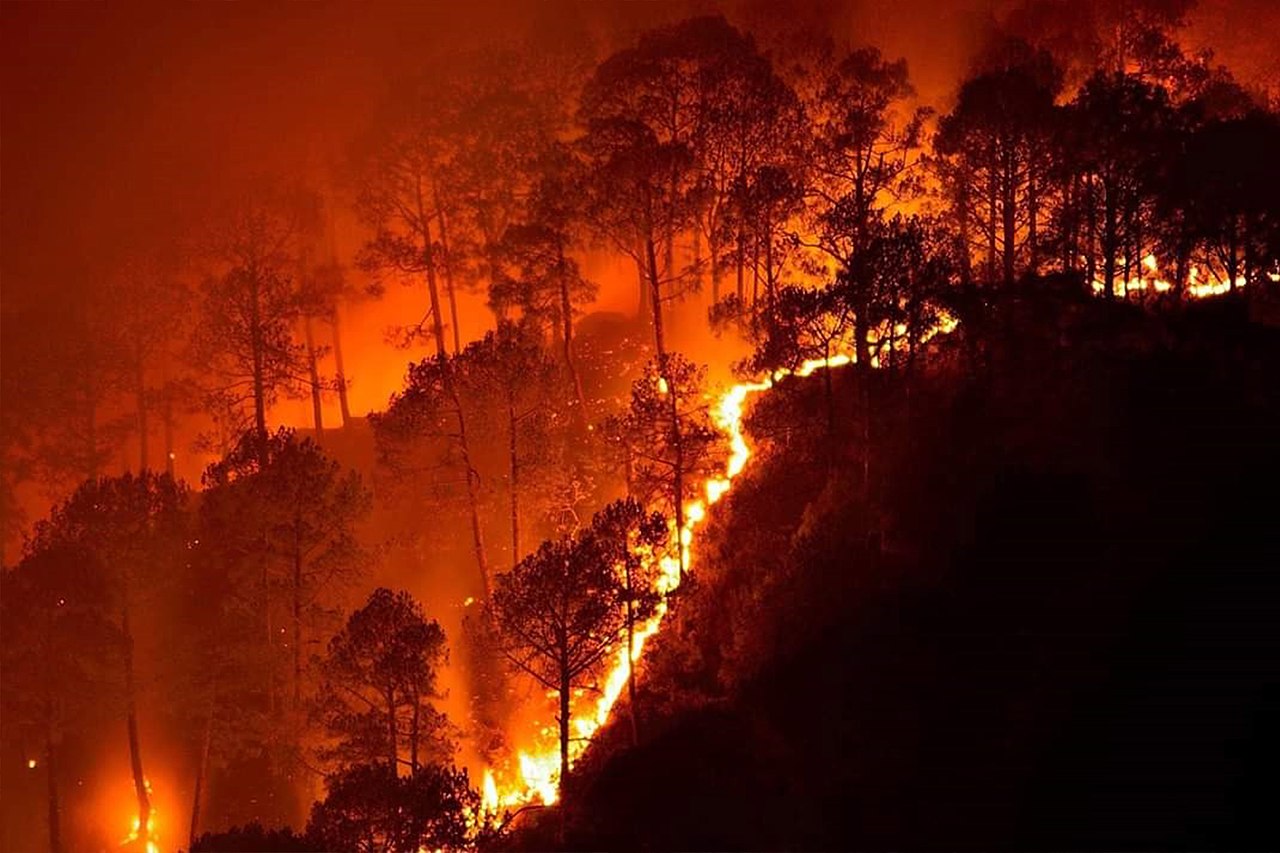
by DGR News Service | Sep 23, 2019 | Biodiversity & Habitat Destruction
By Derrick Jensen
This article was originally published in the Fair Observer, and is republished here with the authors permission. Featured image by NaveenNkadalaveni, CC BY-SA 4.0.
The Amazon is burning. This is what the end of the world looks like. Oh, and there’ll be more forests burned, more forests felled by chainsaws, more wetlands drained, more rivers dammed, more grasslands plowed, oceans further toxified and emptied of fish.
And each of these is what the end of the world looks like.
The end of the world looks like factory trawlers pulling in net after net full to bursting with fish — the fish’s eyes popping out from the pressure of all those bodies squeezed together. It looks like puffins starving to death. It looks like emaciated polar bears. It looks like whales washing up on shore and walruses not finding ice on which to rest.
The end of the world looks like plows digging into grasslands, turning over soil and killing all who live there, even down to bacteria. It looks like rows of monocrops, as far as the eye can see.
The end of the world looks like humans staring at screens, clucking their tongues at the destruction of forests far away, never noticing that they themselves — whether they’re in London, New York, Paris, Rome, Athens, Beirut, Beijing or Baghdad — are standing in clear-cuts.
The end of the world looks like cities, with most of their residents never giving a thought to who and what was killed to build that city, never giving a thought to who and what was killed to mine, manufacture and move everything they consider necessary to their lives, and never thinking about what is necessary to life and what is not.
The end of the world looks like humans turning the planet to human use. Or rather attempting to, because it’s not possible to turn this wild and fecund Earth totally to human use, and this attempting is itself what is causing the end of the world.
From the beginning of this culture, it has been so. When you think of Iraq, is the first thing you think of cedar forests so thick that sunlight never touches the ground? That’s what it was like, prior to the beginning of this culture. The first written myth of Western civilization is Gilgamesh deforesting the hills and valleys of Iraq to make a great city.
Have you heard of Mesopotamian elephants? Most of us haven’t. They were exterminated to make way for this culture. And when you think of the Arabian Peninsula, do you think of oak savannas? These forests were cut for export to fuel the economy, to build cities.
The Near East was heavily forested. We’ve all heard of the cedars of Lebanon. They still have one on their flag. The great forests of North Africa were felled to make the Phoenician and Egyptian navies. Greece was heavily forested. So was Italy. So was France. The great forests of Britain came down to make the navy that allowed the sun never to set on the British Empire.
This is what this culture does. Forests precede us and deserts dog our heels.
The end of the world was not written into human existence. For most of our species’ time on Earth, we’ve lived sustainably. The Tolowa Indians lived where I live now for at least 12,500 years, and when the dominant culture arrived, salmon still ran so thick they turned entire rivers “black and roiling” with their bodies. There was no such thing as “ancient redwood forests.” There was only “home” — a home filled with trees thousands of years old, a home filled with nonhumans in abundance most of us literally cannot conceptualize.
Can you imagine — and this moves us across the continent — flocks of passenger pigeons so large they darken the sky for days at a time, flying 60 miles per hour and sounding like rolling thunder? Can you imagine so many whales that the air looks foggy, just from their breath? Can you imagine fish in such abundance that they slow the passage of ships? Can you imagine entire islands so full of great auks that one European explorer said they could load every ship in France and it would not make a dent? Well, they did, and it did, and the last great auk was killed in the 19th century.
How did the world get to be so full of life in the first place? By each creature making the world richer by living and dying. Salmon make forests stronger by their lives and deaths. Redwood trees do the same. Buffalo make grasslands stronger by their lives and deaths. Wolves do the same. And humans can do the same. But not living the way we do.
The Tolowa were not alone in their sustainability. There have been sustainable cultures the world over. The San of southern Africa, for example, evolved in place. They have lived there, in human terms, forever.
And how have humans lived sustainably in place? Simple. By not destroying the places where they lived, and by not destroying other places either. By improving the habitat on its own terms by their presence. The Tolowa made land-use decisions, just as all other beings on the land do, and just as we make land-use decisions. But the Tolowa made these land-use decisions on the assumption they would be living in a place for the next 500 years. That assumption changes everything about how you make decisions and how you live. It is the difference between life and death, between sustainability and the end of the world.
The end of the world was not written into human existence. It was, however, written into the story of Gilgamesh. The end of the world is written into this way of life of converting the Earth solely to human use. It was written into existence with the plow, and with the cities the plow makes possible.
The logic is simple and inescapable. If you convert the land that previously grew bushes and trees that fed elephants into wheat that feeds humans, you can grow more humans per hectare. Many of these humans can become a standing army. And you can use those trees you cut down to build ships of war. You now have a competitive military advantage over those who live sustainably, over those who do not destroy their land base. Further, because you’ve degraded your own land base, you must expand into other land bases. But fortunately for you, you’ve got a standing military.
This is the last 6,000 years of history. This is the story of the end of the world.
More than 90% of forests on the planet have been destroyed. The same is true for wetlands, grasslands, seagrass beds, large schools of fish, wildlife populations in general.
This culture is killing the planet. It doesn’t have to be this way. Not every culture has lived this way. Not every culture has killed the planet.
Recently, more and more people are talking about the possibility of human extinction. That possibility has entered our consciousness enough that, in December 2018, The New York Times published an op-ed asking whether it would be better for the Earth if humans went extinct.
As the Amazon burns, here’s the thing that haunts me. How is it that this culture can contemplate the end of the Amazon rainforest, contemplate the end of elephants, great apes, insects, fish in the oceans? How is it that it can blithely destroy life on Earth? How is it that it can with not much horror contemplate human extinction, but cannot contemplate stopping this way of life?
If aliens came from outer space and did to Earth what this culture is doing — change the climate; burn the Amazon; deforest the planet; vacuum the oceans and put dioxin in every mother’s breastmilk; and bathe the world in plastics, endocrine disrupters and neurotoxin — we would know exactly what to do. We would resist. We would fight as though our lives depend on it. We would destroy the aliens’ infrastructure that allows them to wage war on the planet that is our only home.
Or, put another way, if the Amazon could take on human manifestation, what would it do? If salmon could take on human manifestation, how long would dams stand? If humans from the future could come to our time, how would they act?
As the writer Lierre Keith often says, “If there are any humans left 100 years from now, they are going to ask what the fuck was wrong with us that we didn’t fight like hell when the world was going down.”
Many of us who know history might have fantasies of how we would have acted were we alive under German occupation in World War II or under British colonial rule. Right now, we are facing the end of the world. We have the opportunity and the honor to protect the planet that gave us our lives.
The time is now. Roll up your sleeves and get to work. Life on this planet needs you.










 In India and Nepal, two “development” projects have been proposed that require felling of trees. In Mumbai, over 2600 trees in the Aarey area are to be felled to build a car shed (parking garage) for the Mumbai Metro Rail Corporation (MMRC). Aarey is a lively forest with a thriving natural community (aka ecosystem). Yet, Bombay High Court has failed to acknowledge Aarey as a forest. Meanwhile in Nepal, the ring road (encircling the Kathmandu valley) is set for its second phase of road expansion that is going to cut more than 2000 trees.
In India and Nepal, two “development” projects have been proposed that require felling of trees. In Mumbai, over 2600 trees in the Aarey area are to be felled to build a car shed (parking garage) for the Mumbai Metro Rail Corporation (MMRC). Aarey is a lively forest with a thriving natural community (aka ecosystem). Yet, Bombay High Court has failed to acknowledge Aarey as a forest. Meanwhile in Nepal, the ring road (encircling the Kathmandu valley) is set for its second phase of road expansion that is going to cut more than 2000 trees. In Kathmandu, cutting down trees began during a major festival of the country. Kathmandu, being the capital, is populated with many immigrants from all over the country. During this time, most return to their natal homes to celebrate the biggest festival of the year with their family and relatives. As a result, the valley is relatively sparsely populated. It was during this opportunistic period that felling of trees began.
In Kathmandu, cutting down trees began during a major festival of the country. Kathmandu, being the capital, is populated with many immigrants from all over the country. During this time, most return to their natal homes to celebrate the biggest festival of the year with their family and relatives. As a result, the valley is relatively sparsely populated. It was during this opportunistic period that felling of trees began.
